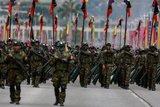Rockwell Collins demonstrates advanced military networking capabilities at JEFX 2010
Rockwell Collins recently conducted successful demonstrations of the Tactical Targeting Network Technology (TTNT) and Quint Networking Technology (QNT) at the Joint Expeditionary Forces Experiment (JEFX) 10-3 held at Nellis Air Force Base.
The focus of JEFX 2010 was irregular warfare with initiatives centered on Command and Control (C2), Intelligence, Surveillance and Reconnaissance (ISR) and close precision engagement. TTNT and QNT were utilized to enable quick communication, collaboration and networking capability to units at the tactical edge, reducing the "Find, Fix, Track, Target, Engage and Assess" (F2T2EA) timelines associated with ground fighter engagement.
Platforms utilizing TTNT and QNT at JEFX 2010 included E-2C and E-3 C2 aircraft, F-16 aircraft, the Northrop Grumman Litening targeting pod, Orion UAV surrogate and special operations forces on the ground.
"These successful demonstrations further prove that TTNT and QNT are the future when it comes to providing the warfighter with secure networking capability at the tactical edge," said Bruce King, vice president and general manager of Surface Solutions for Rockwell Collins. "TTNT and QNT are the most mature advanced tactical data links providing airborne networking capability for warfighters. This capability has been proven and demonstrated through more than 1,000 flight hours on over a dozen airborne and ground platforms."
The Rockwell Collins TTNT design features state-of-the art mobile, high-speed, ad hoc networking technology that will deliver simultaneous voice, data and video services. TTNT also provides a high-throughput, low-latency solution for applications requiring real-time information. QNT provides a robust and affordable miniature networking data link solution suitable for use on weapons and by tactical UAVs.
Specific initiatives enabled by TTNT and QNT at JEFX 2010 included:
* "Fires From Above," which helped provide a fusion of ISR information to Air Force Special Operations Command Tactical Air Control Party (TACP) airmen, air and C2 assets
* The Battlefield Air Operations (BAO) kit interoperability initiative, which used TTNT to evaluate C2 nodes' ability to support Special Operations Forces and Combat Air Forces engagement of mobile targets in urban and rugged environments
* Netcentric Airborne Command and Control initiative, which used TTNT radio integration into E-2 and E-3 platforms for increased situational awareness and collaboration among C2 elements
* The Joint Fighting Information to the Tactical Edge (JFITE) initiative, which used TTNT and QNT to integrate ISR and strike support in wireless wide area networking and wireless local area networking scenarios
Source: Rockwell Collins
More from Digital Battlespace
-
![Babcock nears first customer for Nomad AI translation tool]()
Babcock nears first customer for Nomad AI translation tool
Nomad can provide militaries with real-time intelligence, saving critical time on the battlefield.
-
![AUSA 2025: Israel’s Asio Technologies to supply hundreds of improved Taurus tactical systems]()
AUSA 2025: Israel’s Asio Technologies to supply hundreds of improved Taurus tactical systems
Taurus operates alongside the Israel Defense Forces’ Orion system which supports mission management across tens of thousands of manoeuvring forces, from squad leaders to battalion commanders.
-
![AUSA 2025: Kopin pushes micro-LED plans as China moves faster]()
AUSA 2025: Kopin pushes micro-LED plans as China moves faster
The plan for the new displays follows fresh investment in Kopin’s European facilities by Theon and an order for head-up displays in fielded aircraft, with funding from the US Department of Defense.
-
![AUSA 2025: Persistent Systems to complete its largest order by year’s end]()
AUSA 2025: Persistent Systems to complete its largest order by year’s end
Persistent Systems received its largest ever single order for its MPU5 devices and other systems earlier this month and has already delivered the 50 units to the US Army’s 4th Infantry Division.
-
![Aselsan brings in dozens of companies and systems under the Steel Dome umbrella]()
Aselsan brings in dozens of companies and systems under the Steel Dome umbrella
Turkey has joined the family of countries attempting to establish a multilayered air defence system with government approval in August 2024 for the effort landed by Aselsan. Dubbed Steel Dome, the programme joins Israel’s Iron Dome, the US Golden Dome, India’s Mission Sudarshan Chakra and South Korea’s low-altitude missile defence system.
-
![DSEI 2025: MARSS unveils new agnostic multidomain C4 system]()
DSEI 2025: MARSS unveils new agnostic multidomain C4 system
MARSS’ NiDAR system has been deployed using sensors from static platforms to provide detection and protection for static sights, such as critical infrastructure, ports and military bases.



























